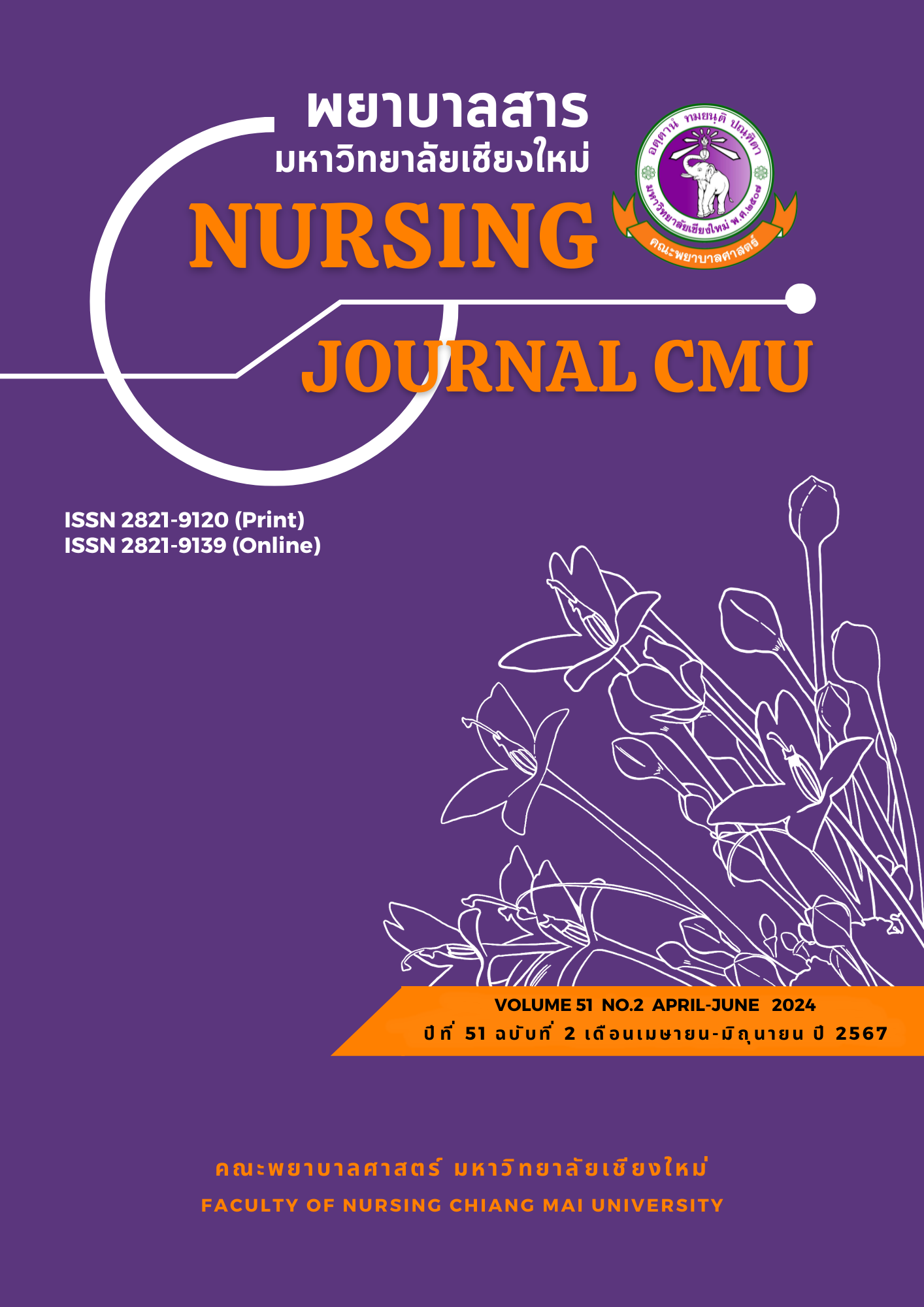Effects of Wound Irrigation Using Pressure Controlled Technique on Wound Infection and Satisfaction Towards Wound Cleansing Among Persons with Large Laceration Wounds
Keywords:
Laceration wound, Wound cleansing, Wound irrigation, Wound Infection, SatisfactionAbstract
Wound cleansing is an essential procedure for decreasing the likelihood of wound infection. This quasi-experimental research aimed to examine the effects of wound irrigation using a pressure-controlled technique on wound infection and satisfaction towards wound cleansing among persons with large laceration wounds. The participants included 58 persons with lacerated wound lengths of more than 5 cm receiving care at an emergency room. There were 29 participants in the control group and the experimental group. The participants in both groups were matched by wound cause, wound size, wound location, age, history of diabetes mellitus, history of cancer, smoking, and receiving antibiotics. The research instrument was the pressure-controlled wound irrigation equipment. The data collection instruments were the Lacerated Wound Infection Evaluation Form and the Satisfaction Towards Wound Cleansing Evaluation Form, the latter of which was evaluated for validity by five experts yielding an index of item-objective congruence between .80-1. It was also checked for its test-retest reliability, yielding a Pearson’s correlation coefficient of .82. Data were analyzed using descriptive statistics, Fisher’s Exact Probability test, and Mann-Whitney U test.
The results revealed that the wound infections among the experimental group were statistically significantly lower than those of the control group (p < .05). None of the participants in the experimental group had wound infection, while six participants in the control group (20.69%) had wound infection. The satisfaction towards wound cleansing among the experimental group (M = 4.97, SD = 0.19) was statistically significantly higher than that of the control group (M = 4.72, SD = 0.53) (p < .05).
The results of this study reveal that wound irrigation using a pressure-controlled technique can reduce wound infection and increase satisfaction towards wound cleansing among persons with large laceration wounds.
References
Akiki, R. K., & Mehrzad, R. (2020). Practical management of common skin injuries, lacerations, wounds, trigger fingers, and burns. Journal of the American Board of Family Medicine, 33(5), 799-808. https://doi.org/10.3122/jabfm.2020.05.200017
Bussa, V., Wangsrikhun, S., & Sukonthasarn, A. (2017). Effects of wound irrigation using pressure controlled technique on satisfaction and infection among persons with lacerated wound. Nursing Journal, 44(4), 49-60. (in Thai)
Center for Disease Control and Prevention. (2013). National healthcare safety network (NHSH). https://www.cdc.gov/nhsn/index.html
Chisholm, C. D., Cordell, W. H., Rogers, K., & Woods, J. R. (1992). Comparison of a new pressurized saline canister versus syringe irrigation for laceration cleansing in the emergency department. Annals of Emergency Medicine, 21(11), 1364-1367. https://doi.org/10.1016/S0196-0644(05)81903-1
Cohen, M. (1988). Statistical power analysis for the behavioral sciences (2nd ed.). Lawrence Erlbaum Associates.
Forsch, R. T. (2008). Essentials of skin laceration repair. American Family Physician, 78(8), 945-951.
Healthcare Accreditation Institute. (2022). Hospital and healthcare standards. The Healthcare Accreditation Institute (Public Organization). (in Thai)
Hollander, J. E., & Singer, A. J. (1999). Laceration management. Annals of Emergency Medicine, 34(3), 356-367. https://doi.org/10.1016/s0196-0644(99)70131-9
Hollander, J. E., Singer, A. J., Valentine, S. M., & Shofer, F. S. (2001). Risk factors for infection in patients with traumatic lacerations. Academic Emergency Medicine, 8(7), 716-720. https://doi.org/10.1111/j.1553-2712.2001.tb00190.x
International Wound Infection Institute. (2022). Wound infection in clinical practice. http://www.woundsinternational.com
Lewis, K., & Pay, J. L. (2023). Wound irrigation. StatPearls. https://www.ncbi.nlm.nih.gov/books/NBK538522/
Mankowitz, S. L. (2017). Laceration management. Journal of Emergency Medicine, 53(3), 369-382. https://doi.org/10.1016/j.jemermed.2017.05.026
Mitsungnern, T., Kotruchin, P., Phu-ngoen, P., Tacha-a-tik, P., Prasanson, T., Sumritrin, S., & Lathum, K. (2016). Customers’ satisfaction and causes of satisfaction in emergency room, Srinagarind Hospital 2014. Srinagarind Medicine Journal, 31(4), 202-212. (in Thai)
National Health Service. (2019). Hospital accident & emergency activity 2018-19. https://digital.nhs.uk/data-and-information/publications/statistical/hospital-accident--emergency-activity/2018-19
Otterness, K., & Singer, J. A. (2019). Updates in emergency department laceration management. Clinical Experimental Emergency Medicine, 6(2), 97-105. https://doi.org/10.15441/ceem.18.018
Phayao hospital. (2022). Annual statistical report. Emergency Room Phayao Hospital. (in Thai)
Prevaldi, C., Paolillo, C., Locatelli, C., Ricci, G., Catena, F., Ansaloni, L., & Cervellin, G. (2016). Management of traumatic wounds in the emergency department: Position paper from the academy of emergency medicine and care (AcEMC) and the world society of emergency surgery (WSES). World Journal of Emergency Surgery, 11, 30. https://doi.org/10.1186/s13017-016-0084-3
Quinn, J. V., Polevoi, S. K., & Kohn, M. A. (2014). Traumatic lacerations: What are the risks for infection and has the 'golden period' of laceration care disappeared? Emergency Medicine Journal, 31(2), 96-100. https://doi.org/10.1136/emermed-2012-202143
Singer, A. J., Hollander, J. E., Subramanian, S., Malhotra, A. K., & Villez, P. A. (1994). Pressure dynamics of various irrigation techniques commonly used in the emergency department. Annals of Emergency Medicine, 24(1), 36-40.
Stevens, R. J. G., Gardner, E. R., & Lee, S. J. (2009). A simple, effective and cheap device for the safe irrigation of open traumatic wounds. Emergency Medicine Journal, 26(5), 354-356. https://doi.org/10.1136/emj.2007.055343
White, W., & Asimus, M. (2014). Assessment and management of nonviable tissue: Wound management for the advanced practitioner. IP Communications.
Wolcott, R., & Fletcher, J. (2014). The role of wound cleansing in the management of wound. Wound International 2014, 1(1), 25-31. https://woundsinternational.com/wp-content/uploads/sites/8/2023/02/randall.pdf
Wynne, M. (2018). HSE National wound management guidelines 2018. https://healthservice.hse.ie/about-us/onmsd/quality-nursing-and-midwifery-care/hse-national-wound-guidelines-2018.html
Downloads
Published
How to Cite
Issue
Section
License
Copyright (c) 2024 Nursing Journal CMU

This work is licensed under a Creative Commons Attribution-NonCommercial-NoDerivatives 4.0 International License.
บทความที่ได้รับการตีพิมพ์เป็นลิขสิทธิ์ของวารสารพยาบาลสาร
ข้อความที่ปรากฏในบทความแต่ละเรื่องในวารสารวิชาการเล่มนี้เป็นความคิดเห็นส่วนตัวของผู้เขียนแต่ละท่านไม่เกี่ยวข้องกับมหาวิทยาลัยเชียงใหม่ และคณาจารย์ท่านอื่นๆในมหาวิทยาลัยฯ แต่อย่างใด ความรับผิดชอบองค์ประกอบทั้งหมดของบทความแต่ละเรื่องเป็นของผู้เขียนแต่ละท่าน หากมีความผิดพลาดใด ๆ ผู้เขียนแต่ละท่านจะรับผิดชอบบทความของตนเองแต่ผู้เดียว






